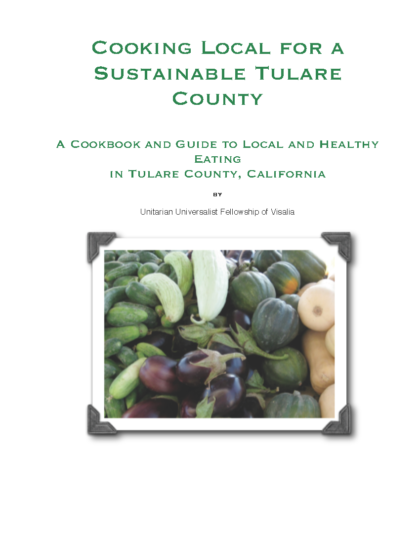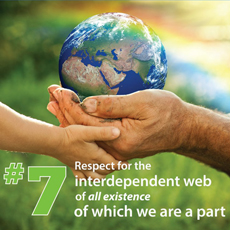Cooking Local Cookbook

Cooking Local for a Sustainable Tulare County: A Cookbook and Guide to Local and Healthy Eating in Tulare County, California
This is our congregation’s “Ethical Eating” Cookbook. Our cookbook is intended to provide a selection of guidelines and delicious recipes that safeguard the health of the planet.
Our Cookbook helps us learn how to cook from locally-grown fruits and vegetables of Tulare County.
The recipes shared have been “truth-tested” in our weekly shared meals at the Unitarian Universalist Fellowship of Visalia.
Included are not only recipes, but reflections, guidelines, and meal blessings, to help us live more sustainably for the people and the planet.
You can download a free PDF of the Cooking Local Cookbook here.
We only have a few copies of the print edition left. For the printed edition, we hope you will give a $15.00 donation. (Shipping: $5.50 priority mail or pick up free in-person at a Sunday service.
Size: 8 1/2 x 11, comb binding.
To purchase, send your request to: harold.wood@uuvisalia.org.
For more information, see Cookbook Flyer (PDF – download via box.com)
Our Eating and Cooking Philosophy:
With gratitude and reverence for all life, we savor food mindful of all that has contributed to it. We commit ourselves to a more equitable sharing of the earth’s bounty.
3 Principles of Health Eating for Yourself and the Planet
EAT Local:
* If you care about climate change, don’t buy food that has traveled hundreds or thousands of miles by plane and truck to get to you.
* If you care about open spaces, buy food that is grown on small local farms, which help keep open spaces from being paved over.
* If you care about stopping sprawl, buy from local producers rather than from big chain stores.
EAT Organic:
* If you care about biodiversity and endangered species, don’t buy food that is produced with toxic pesticides, which kill all sorts of creatures.
* If you care about climate change, don’t buy food that is grown with petroleum-based fertilizers.
* If you care about clean air, water and soil, look for food that is
grown on farms where farmers don’t use chemical pesticides that are sprayed from the air and leach into the water and soil.
EAT more vegetables, fruits, nuts, grains, and seeds:
* If you care about forests, wild places, biodiversity, and endangered species, you should know that a leading cause of deforestation in the Americas and elsewhere is the raising of cattle and their feed.
If you care about clean water and soil, don’t buy meat from factory farms where animals are raised in confined operations so that their wastes poison the air, soil and water around them.
We can make a difference by ethically eating:
Most of the world’s problems can’t be fixed by individual action: disease, war, and poverty require concentrated efforts international action and governments. But ONLY consumers can affect the way food is grown and transported; this is an area where our actions make a difference. If we buy food that’s grown sustainably, then supply will follow demand and it will become more available.
We can make a difference by ethically eating
Here’s what you can do:
• Find out where the food you eat comes from and how it’s grown, raised, and processed. Get to know the farmers who grow your food and support them.
• Buy food that is grown locally. Fresh food from local farmers is more nutritious and avoids pollution caused by transporting food.
• Eat seasonally; you might find blueberries and peaches in Northern supermarkets in February, but they’ve been shipped from far away—and they’re probably tasteless, anyway. Wait for the delicious produce that’s grown in your area and you’ll enjoy the pleasure of anticipation and learning the rhythm of the seasons.
• Eat the greatest variety of the least processed food and eat less of it.
• Buy organic whenever you can. Organic farmers don’t use the chemicals that are polluting our water, air, and soil.
• Start your own organic garden—you can never get fresher food than by growing it yourself!
• Eat less meat. Fruits, vegetables, grains, beans, and seeds are healthier and more sustainable
• Eat with family and friends; learn to cook; share recipes and your knowledge of sustainability.
• Buy grass-fed, free-range, or pasture-raised meat and dairy. Avoid corn-fed beef.
• Try “Sustainable Tuesdays”
•Shop at farmers’ markets and farmstands; find one at
www.localharvest.org or sustainabletable.org.
• Join a CSA, a food co-op that supports a local farm. Check www.csacenter.org or these local CSAs:
Tulare County: www.familyfarmfresh.com and
www.abundantharvestorganics.com
Fresno County: www.tdwilleyfarms.com/
• Eat fish that is raised sustainably.
Learn more at Seafood Watch.
• Ask restaurants, stores, and schools where they get their food. Support those that buy locally.
www.chefscollaborative.com, www.dinegreen.com.
Top 10 Food Rules:
- Avoid food products containing ingredients that no ordinary human would keep in the pantry.
- Avoid food products that contain high-fructose corn syrup.
- Shop the peripheries of the supermarket and stay out of the middle.
- If it came from a plant, eat it; if it was made in a plant, don’t.
- Eat mostly plants, especially leaves.
- Treat meat as a flavoring or special occasion food.
- Pay more, eat less.
- Eat when you are hungry, not when you are bored.
- “Breakfast like a king, lunch like a prince, dinner like a pauper.”
- Limit your snacks to unprocessed plant foods.
Finding Locally Grown Food
It’s easier than ever to find local or regionally grown food. Below are listed some of the best web resources for locating your nearest options for local food. As our demand for local foods grows, our options will increase, so don’t be afraid to ask for local food wherever you shop.
Tulare County and San Joaquin Valley Web Sites
Farmer’s Markets:
Visalia Farmer’s Market: This should be your first stop for groceries every week! You can get not only fresh fruits and vegetables, but all the basics: bread, eggs, milk, grass-fed beef, etc.
http://visaliafarmersmarket.com/
https://www.facebook.com/visaliafarmersmarket
Other Local Food in Tulare County: There are Farmer’s Markets in Farmersville, Tulare, Lindsay,Woodlake, Porterville and other communities in Tulare County
http://www.tastetularecounty.org/taste/index.cfm/farmers-market/
Local Community Supported Agriculture:
Tulare County: www.familyfarmfresh.com
Abundent Harvest Organics: www.abundantharvestorganics.com
Fresno County: www.tdwilleyfarms.com/
Classes and Programs:
The Seasonal Table – COS instructor Chef Debb provides seasonal recipes for our area:
http://www.seasonaltable.blogspot.com/
Other Local:
Central Valley Buy Fresh, Buy Local Guide – Lists farmer’s Markets, Community Supported Agriculture programs, a seasonality chart for the San Joaquin Valley, and many other resources.
http://www.csufresno.edu/ccchhs/institutes_programs/CCROPP/documents/bfbl_web.pdf
National Websites
LocalHarvest is our recommended choice as a starting point for connecting with local growers and finding sources for locally and sustainably produced foods. This site allows the user to search for farmers markets, CSAs, direct farm sales, restaurants, grocery stores, and other local food sources. In addition it provides forums for various farming topics. Worth a visit!
The New Farm Farm Locator provides a search resource for locating fresh local food sources, and provides the reverse: finding markets for farmers and producers.
Farmers’ Markets
Probably the best option for most people is to locate an active Farmers’ Market, where farmers and growers sell their produce and value-added goods directly to consumers. Since passage of the Farmer-to-Consumer Direct Marketing Act of 1976, active farmers’ markets have grown from about 350 to well over 4000 today, or an average of 80 per state. Most urban areas host farmers’ markets from spring until fall; some are open all year. Market rules usually guarantee that the products are fresh and local. You can find your nearest farmers’ markets and local producers on the USDA farmers’ market website.
Community Supported Agriculture (CSA)
In a typical CSA, subscribers pay a producer in early spring and then receive a weekly share of the produce all season long. Many community-supported agriculture (CSA) operations allow or sometimes even require subscribers to participate on their farms; they might even offer a work-for-food arrangement.
The Biodynamic Farming and Gardening Association provides CSA information and state-specific search options.
The Robyn Van En Center at Wilson College also hosts an information and CSA finder.
Urban and Community Gardens
If you don’t have any land, in most urban areas you can find some opportunity to garden. Most urban areas also host community gardens, using various organizational protocols – a widespread practice in European cities that has taken root here. Some rent garden spaces to the first comers; others provide free space for neighborhood residents. Some are organized and run by volunteers for some specific goal, such as supplying food to a local school, while others accommodate special needs of disabled participants or at-risk youth. Information and locations can be found at the American Community Garden Association site.
The ACGA also provides links for finding community gardens.
City Farmer is a related organization for information on urban gardening in Canada.
Home Grown
Container gardening on porches, balconies, back steps, or even a sunny window can yield a surprising amount of sprouts, herbs, and even produce. Just a few tomato plants in big flowerpots can be surprisingly productive. If you have any yard at all, part of it can become a garden. You can spade up the sunniest part of it for seasonal vegetables, or go for the more understated option of using perennial edibles in your landscaping. Fruit, nut, citrus, or berry plants come in many attractive forms, with appropriate choices for every region of the country. While gardening as a topic is too broad to cover adequately in just a few links, a good starting point is at The National Gardening Association
Source:
http://www.animalvegetablemiracle.com/LocatingLocal.html

